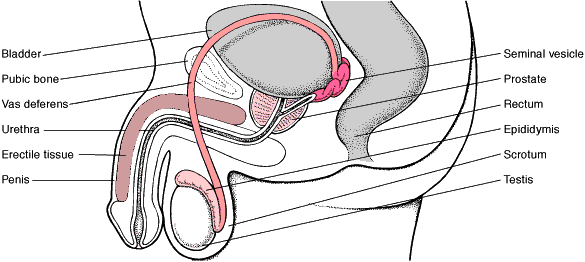In an adult male, sperm are being formed continuously (spermatogenesis) in the testes. A nonspecialized cell requires about 72 to 74 days to develop into a mature sperm cell. From each testis, sperm move to the epididymis (a coiled tube located on top and down the back of the testis), where they are stored until ejaculation is about to occur. From the epididymis, sperm move through the vas deferens and the ejaculatory duct. In the ejaculatory duct, fluid produced by the seminal vesicles is added to the sperm to form semen, which moves through the urethra to be ejaculated.

To be fertile, a man must be able to deliver an adequate quantity of normal sperm to a woman's vagina.
Various factors can interfere with this process, causing infertility.
An increase in the temperature of the testes from a prolonged fever or exposure to excessive heat can greatly reduce sperm count, decrease the vigor of sperm movement, and increase the number of abnormal sperm in semen. (Semen Analysis) Sperm formation is most efficient at about 93.2° F., which is lower than normal body temperature. The testes, where sperm are formed, can be kept at this lower temperature because they are located in the scrotum, which is outside the body cavity.
Complete absence of sperm (azoospermia) results from a serious disorder within the testes or from blocked or missing vas deferens (on both sides). Semen that doesn't contain fructose, a sugar produced by the seminal vesicles, indicates that the vasa deferentia or seminal vesicles are missing or the ejaculatory ducts are blocked.
A varicocele, the most common anatomic abnormality in infertile men, is a mass of elongated, widened, snakelike veins in the scrotum, similar to varicose veins. It feels like a bag of worms. This abnormality may prevent proper drainage of blood from the testes, thus raising their temperature and reducing the rate of sperm formation.
More unusually, semen can travel in the wrong direction (retrograde ejaculation)--it backs up into the bladder instead of traveling down the penis. This disorder is more common in men who have had pelvic surgery, particularly prostate removal, and in men who have diabetes. Retrograde ejaculation can also result from abnormal nerve function
Treatment depends on the cause of infertility.
Clomiphene, a drug used to induce ovulation in women, can be used to try to increase sperm counts in men. However, clomiphene doesn't seem to improve the sperm's ability to move or to reduce the number of abnormal sperm, and it hasn't been proved to increase fertility.
For men who have few normal sperm, artificial insemination may slightly enhance pregnancy rates because it uses the first portion of the ejaculated semen, which has the greatest concentration of sperm. In vitro fertilization and gamete intrafallopian tube transfer (GIFT), which are much more complex and costly procedures, are successful in treating certain types of male infertility.IVF Clinics
If a man produces no sperm, inseminating the woman with sperm from another man (a donor) can be considered. Because of the danger of contracting sexually transmitted diseases, including AIDS, fresh semen samples from donors are no longer used. Instead, frozen sperm samples should be obtained from a certified sperm bank, which has tested the donors for sexually transmitted diseases. However, pregnancy is less likely to result when frozen, rather than fresh, sperm samples are used.
Varicoceles can be treated with minor surgery. Studies suggest that pregnancy results in 30 to 50 percent of cases after the male partner has had varicocele surgery, but additional studies are needed for confirmation.